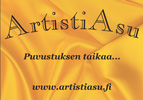 Anna, Princess, maintained that she was born to the royal family in Buckingham Palace, England. When she was under a year old, a griffin snatched her from the pram and took her across the skies to Finnish Lapland, where she arrived on a summery bed of lichen from which the Lapps took her into their care.
Anna, Princess, maintained that she was born to the royal family in Buckingham Palace, England. When she was under a year old, a griffin snatched her from the pram and took her across the skies to Finnish Lapland, where she arrived on a summery bed of lichen from which the Lapps took her into their care.
In reality, Anna Lappalainen was born in rural Kuopio County on 27th June 1896. Her father died when she was 4 years old, and her mother was unable to support the family’s three children. Anna was placed into foster families in Helsinki: according to various sources, she had lived in 7-15 foster homes by the age of 13.
At 18 years of age, Anna sought to become a model at the Ateneum art school and the University’s drawing department. Soon after this, she also started to demonstrate her skills in singing and performing. Anna became a regular guest star at the city’s cafes and cinemas.
After suffering a severe case of bronchitis, Anna was forced to give up her singing work, and began a course in massage. She became such a competent masseuse that several doctors would refer their patients to her directly.
At 30 years of age, Anna married Arthur Svedholm, a Swedish-speaking gardener 15 years her senior. Their happiness, however, lasted only 2 and a half years. Anna’s difficulties multiplied after the divorce. She wasn’t able to pay her rent, and her erratic behaviour induced suspicion and aggravation amongst her neighbours. The authorities were notified and she was taken into psychiatric care at Kivelä hospital.
When released from short-term care, Anna attempted to live with her mother. The arrangement, however, did not work out. Anna behaved aggressively towards her mother and their relationship was strained. Anna was sent to Lapinlahti hospital where she was diagnosed with manic depression, psychosis, and mania. This period in hospital was followed by another attempt to live with her mother, only to be followed by another period at Lapinlahti, with Anna finally ending up at Kellokoski Psychiatric Hospital in 1933.
In Kellokoski, Anna announced that she was “Princess”, and became a well-known patient and something of an entertainer. She liked to perform, and sing the funny tunes written by J. Alfred Tanner and Oskari Nyström. Anna’s tours de force were the Midsummer Eve concerts on the 3rd floor balcony of Kellokoski hospital, from which her voice resounded loudly across the grounds.
Anna was also very talented with her hands. The Chief Physician at Kellokoski, Paavali Alivirta, received a hand-knitted vest as a gift from Anna, and wore it at the hospital on national holidays. Anna also made numerous highly original artworks, which have been exhibited in Paris as well as at the Helsinki Kunsthalle. The Virgin Mary was a recurring theme in her works, which one might interpret as a reference to Anna’s traumatic relationship with her mother.
Having free passage around the hospital area, Anna was able to continue her work as a masseuse. She often stopped by at villagers’ houses, rang their doorbells with no pre-warning, and gave a massage to everyone present in exchange for a small fee.
Anna was also known for her other endeavours, such as an unforgettable trip to Stockholm, to which the Chief Physician Paavali Alivirta gave his permission. The Princess, together with an aristocratic friend, boarded the Wellamo ship in Helsinki. When the journey commenced, Princess immediately located the main hall and started performing. Her friend and “lady-in-waiting”, in turn, went around making a collection with her flowery hat. On Stockholm’s Kungsgatan, a group of tourists from Kellokoski had seen Princess and her “lady-in-waiting” singing songs on the streets while waving small Finnish flags.
During Anna’s time, her ward at Kellokoski hospital had around 60 patients. They were placed in 4, 6 or 12 person rooms. After securing her “status”, Anna, however, was allowed to reside alone in a small room previously used as a cleaning cupboard. The door to the room often displayed a note reading: “Princess’ room, no entry”.
The hospital staff attempted to call Anna “Mrs Svedholm” or “Anna Lapplainen” for the sake of her treatment, but she did not answer to these titles. Anna was in constant battle for her royal status, particularly with the hospitals long-term Head Nurse Pakalén.
As part of Anna’s illusion of royalty, she gave several of her fellow in-mates a variety of honorary titles, such as Prince Henry of Ireland, Ivan the Terrible, Karl Fazer, Napoleon, etc. The astonishing thing was that each new personality stayed in Anna’s mind for decades. Anna called the Chief Physician Soininen by the name “Father”. After a transferral from his duties due to a “morphine problem”, Anna gave the name to a patient, upon whose release the title moved to the hospital’s janitor Kari Nurminen.
At Kellokoski hospital, Anna was subject to electric shock therapy, malaria treatment, extended narcosis, and isolation. Her last selection of medication included cognac, of which she was allowed a small shot in the evenings.
Despite her illness, Princess was very happy person. She always had the energy to entertain her “court” by singing and offering massages. In collaboration with two bank managers at the nearby Kellokoski village, she also solved the money troubles of those close to her by distributing make-believe cheques. With her positive and luminous personality Anna unarguably healed her entire surroundings.
At 89 years of age, after having spent over 50 years of her life at Kellokoski, Anna was transferred to Nikkilä hospital: from summer palace to winter palace as she herself described it. It was there she passed away at the age of 92, her last words being: “I’m not a princess, I’m Anna Svedholm.”
In 1995, her memory was honored by a memorial monument in the Kellokoski hospital grounds designed by sculptor Rauni Liukko. It is allegedly the only monument in the world dedicated to a psychiatric patient. The statue symbolizes the flow of life, and is a tribute not to Princess alone, but to all patients who have received psychiatric care.
















